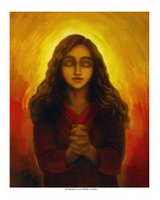


No, I didn't forget about the women. I did go back and look at the gospel accounts of Thursday night, and the only women I could find were the woman with the alabaster jar who appears prior to the Last Supper and the servant girl who afterward provides the occasion for Peter's first denial of Jesus.
But on Friday, as Jesus is formally tried, sentenced, forced through the streets of Jersusalem, crucified, and dies, the women who know him are in evidence, among them Mary Magdalene.
I like Mary Magdalene a lot. I like a woman who goes where she wants to go on her own, asks a lot of questions, and pays close attention to the answers.
So today I started looking for how she has been painted through the ages. She appears as an Eastern Orthodox icon, hair and body fully covered and looking severely at her observer, a serious elder of the church. She is portrayed in some Renaissance paintings as decidedly lacking in clothing, presumably due to her unfortunate mischaracterization as a prostitute by a pope hundreds of years earlier. But there are also some portraits in which she looks more as I would imagine her: solemn, sad, understanding that she is caught up in something beyond comprehension.
But on Friday, as Jesus is formally tried, sentenced, forced through the streets of Jersusalem, crucified, and dies, the women who know him are in evidence, among them Mary Magdalene.
I like Mary Magdalene a lot. I like a woman who goes where she wants to go on her own, asks a lot of questions, and pays close attention to the answers.
So today I started looking for how she has been painted through the ages. She appears as an Eastern Orthodox icon, hair and body fully covered and looking severely at her observer, a serious elder of the church. She is portrayed in some Renaissance paintings as decidedly lacking in clothing, presumably due to her unfortunate mischaracterization as a prostitute by a pope hundreds of years earlier. But there are also some portraits in which she looks more as I would imagine her: solemn, sad, understanding that she is caught up in something beyond comprehension.
As a Jewish woman on an early Friday evening in the spring, she must have been frantic in her grief and her desire to reach the tomb and take proper care of the body. It takes so long to get dark -- almost 9:00 -- and then, unable to work on Saturday, she would have had to wait until daybreak Sunday to leave the house safely. The day or two after a death is always bizarre and confusing; it's easy to imagine Mary and her companions trying to comfort Mary the Mother of Jesus and at the same time approaching the edge of rationality themselves.















2 comments:
These are such rich entries and despite having some background in all of these topics, I'm learning! I enjoyed the Seder entries and the Sister Collette story.
A particularly graphic Good Friday sermon in a Baptist church when I was about 11 had a profound effect on me, but also made me rather dread GF each year. Even though my current church's approach is less graphic, it's still so painful I can hardly bear it. I was surprised some churches are minimizing it, and can sort of see why. We do see the dark side daily --Darfur, Katrina, Iraq. But where's the meaning of the resurrection without the sacrifice?
Thanks for taking the time to share your thoughts and research.
*debbi*
One wonders how the account of Mary being the first one to see the risen Christ ever made it through the patriarchal conrol of the early Church. Perhaps the message of the Almighty--that women are important, no matter how much men through history have attempted to marginalize them--was destined to be communicated regardless.
Debbi's comment made me think... I grew up Catholic. We never minimalized the darkness and horror of the crucifixion. It's odd for me to think that there are churches that would do that.
Post a Comment